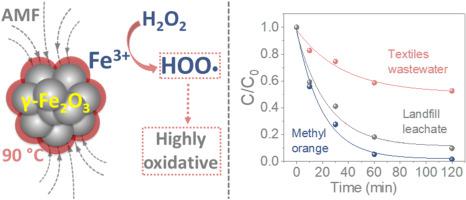Journal of Cleaner Production ( IF 11.1 ) Pub Date : 2021-05-08 , DOI: 10.1016/j.jclepro.2021.127385 Alvaro Gallo-Cordova , Juan José Castro , Elin L. Winkler , Enio Lima , Roberto D. Zysler , María del Puerto Morales , Jesús G. Ovejero , Daniela Almeida Streitwieser

|
Industrial effluents contain a wide range of organic pollutants that present harmful effects on the environment and deprived communities with no access to clean water. As this organic matter is resistant to conventional treatments, Advanced Oxidation Processes (AOPs) have emerged as a suitable option to counteract these environmental challenges. Engineered iron oxide nanoparticles have been widely tested in AOPs catalysis, but their full potential as magnetic induction self-heating catalysts has not been studied yet on real and highly contaminated industrial wastewaters. In this study we have designed a self-heating catalyst with a finely tuned structure of small cores (10 nm) aggregates to develop multicore particles (40 nm) with high magnetic moment and high colloidal stability. This nanocatalyst, that can be separated by magnetic harvesting, is able to increase reaction temperatures (up to 90 ºC at 1 mg/mL suspension in 5 min) under the action of alternating magnetic fields. This efficient heating was tested in the degradation of a model compound (methyl orange) and real wastewaters, such as leachate from a solid landfill (LIX) and colored wastewater from a textile industry (TIW). It was possible to increase reaction rates leading to a reduction of the chemical oxygen demand of 50 and 90 %, for TIW and LIX. These high removal and degradation ability of the magnetic nanocatalyst was sustained with the formation of strong reactive oxygen species by a Fenton-like mechanism as proved by electron paramagnetic resonance. These findings represent an important advance for the industrial implementation of a scalable, non-toxic, self-heating catalysts that can certainly enhance AOP for wastewater treatment in a more sustainable and efficient way.
中文翻译:

用自加热磁性纳米催化剂改善实际废水的降解
工业废水中含有各种各样的有机污染物,它们对环境和贫困社区造成有害影响,无法获得清洁水。由于这种有机物可抵抗常规处理,因此出现了高级氧化工艺(AOP)作为应对这些环境挑战的合适选择。工程氧化铁纳米粒子已在AOP催化中进行了广泛测试,但尚未对真实和高度污染的工业废水中作为磁感应自热催化剂的全部潜力进行研究。在这项研究中,我们设计了一种具有微调小核(10 nm)聚集体结构的自热催化剂,以开发具有高磁矩和高胶体稳定性的多核颗粒(40 nm)。这种纳米催化剂可以通过磁性收集来分离,能够在交变磁场的作用下提高反应温度(在5分钟内1 mg / mL悬浮液中达到90ºC)。在模型化合物(甲基橙)和实际废水(例如来自固体垃圾填埋场(LIX)的渗滤液和纺织工业(TIW)的有色废水)的降解中测试了这种有效的加热。对于TIW和LIX,可以提高反应速率,从而将化学需氧量减少50%和90%。磁性纳米催化剂的这些高去除和降解能力通过类似于Fenton的机制形成强的活性氧物种得以维持,这已通过电子顺磁共振证明。这些发现代表了可扩展,无毒,



























 京公网安备 11010802027423号
京公网安备 11010802027423号